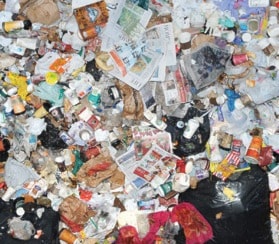Like clockwork, Allan Cheaney awaits his turn to tip the contents of his service truck into the waiting tractor trailer.
He has to speak loudly over the roar of municipal garbage trucks that have congregated at the City of Victoria transfer station where every day is garbage day.
It’s Cheaney’s job to gather up the oddities that are found on city streets – unwanted furniture and mattresses, broken glass, spilled fluids and even animal carcasses – and bring them here to be hauled away to Hartland Landfill in Saanich.
“It’s getting worse, I could do that all day,” Cheaney said of the furniture dumping he sees every day. “It’s starting to be in the more affluent areas.”
On average, every CRD resident generated 413 kilograms of waste in 2009, down from 670 kilograms in 1989.
That may be an improvement, but there is still a long way to go if the Capital Regional District hopes to divert 60 per cent of the waste heading to the landfill by 2013, and 90 per cent by 2020. The goal is to extend the life of Hartland beyond 2040.
The problem is that garbage has become an out-of-sight, out-of-mind issue for many people, said Robert Gifford who has been teaching environmental and consumer psychology at the University of Victoria for the past 31 years.
“We all have lots of things to do in our life,” he said, explaining why few people ponder the implications of what they’re throwing away. “Whatever is in front us right now takes precedence.”
Curbside collection, done weekly in Victoria and bi-weekly in Esquimalt, Saanich and Oak Bay, has offered people convenience, but has cut them off from their relationship with the environment.
“We’re less in touch with nature now and we’re less in touch with garbage now,” Gifford said. “When people see what the impact could be, it changes people’s behaviour.”
About 2,000 people attended Hartland Landfill’s open house last year, where they got up close and personal with some of the landfill’s 48 hectares. In addition, CRD educational campaigns over the years have helped boost recycling efforts. As a result, Hartland Landfill is being filled more slowly than anticipated.
More than 90 per cent of single-family homes in the CRD participate in the blue box recycling program.
More than 19,000 tonnes of recyclables are now diverted from the trash every year.
“People have gotten their heads around recycling,” said Monique Booth, CRD environmental sustainability communications co-ordinator. “There is a behavioural change and a philosophical shift in consumption.”
Still, about 140,000 tonnes of refuse is trucked to the landfill every year.
According to Gifford, some people might not be as honest about their environmental efforts as they say they are.
In three different published studies, evidence shows many people will say they recycle more than they actually do, Gifford explained. Researchers actually looked into blue boxes before they questioned residents.
“In other words, what it shows is you can’t be very confident about what people say,” Gifford said about why people lie about their efforts to be green. “We want to look good.”
To get a better look at what we throw out, how much, and in which neighbourhoods, the CRD conducted a waste composition study for 2009 and 2010, as it does every five years. Out of the samples collected from Victoria, Esquimalt, Saanich, Oak Bay and View Royal, about 30 per cent of the trash was organic waste. Some of the garbage was recyclable -- about 16 per cent was paper and paper products and 13 per cent was plastics.
“There’s still a lot (of recyclables) in the garbage, but there has been a significant drop from 20 years ago,” said Tom Watkins, manager of Hartland operations.
Over at the Victoria waste transfer station, Tej Labh has witnessed a gradual decline in the amount of garbage his solid waste crews collect every year. Last year, 4,800 tonnes was collected, down from 5,000 tonnes in 2008. “People just know now,” said Labh, senior lead hand of Victoria’s solid waste and recycling division. “People are catching on about doing the right thing.”
emccracken@vicnews.com
By the numbers
• 125: Number of hectares Hartland covers, including 48 hectares of landfill area.
• 561: Number of tonnes of asbestos taken to the landfill in 2009.
• 1,600: Number of homes that can be supplied with electricity generated from methane gas produced at Hartland.
• 15: Number of years it takes to secure a new landfill site.
• 25: Number of years Hartland must be monitored after closure. CRD is putting money aside for monitoring costs until 2070.
Thrown away
Results of CRD solid waste composition study, 2009-2010:
Single-family homes:
• Saanich: corrugated cardboard, furniture, clothing, construction materials such as carpet.
• Esquimalt: feminine hygiene products, newsprint such as flyers, glass.
• View Royal: ferrous metals, disposable diapers, animal feces, electronics, kitty litter.
• Victoria: books, footwear, organic waste.
• Oak Bay: tissue paper, paper towels and napkins, aluminum foil and trays, plastics.
• Since 1989, there has been a 42-per-cent drop in the amount of garbage taken to the dump.
Apartments:
• Saanich: organic waste, tissue paper, paper towels, napkins, milk cartons.
• Victoria: electronics, clothing, magazines, cardboard.
• Oak Bay: feminine hygiene products, disposable diapers, glass and household hazardous waste such as empty aerosol cans.
• Esquimalt: small appliances, kitty litter, ferrous metals, furniture.
